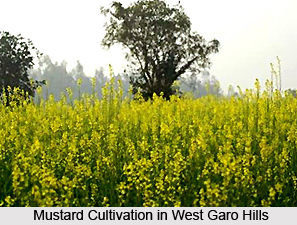 Economy of West Garo Hills District is agrarian in character. Majority of the people of this district of Meghalaya depends on agriculture for their livelihood. The main crop being paddy, the other crops cultivated in West Garo Hills District are mustard, sugarcane, jute, potato, tapioca, cotton, etc. The sizeable crops with commercial potential cultivated in the district are chillies, ginger, pineapple, turmeric and also banana.
Economy of West Garo Hills District is agrarian in character. Majority of the people of this district of Meghalaya depends on agriculture for their livelihood. The main crop being paddy, the other crops cultivated in West Garo Hills District are mustard, sugarcane, jute, potato, tapioca, cotton, etc. The sizeable crops with commercial potential cultivated in the district are chillies, ginger, pineapple, turmeric and also banana.
Wet rice cultivation is practiced in the plain areas of West Garo Hills District while in the hills, the population practice jhum or shifting cultivation. With the passing of time, and the increasing pressure of population, the jhum cycle has been considerably reduced, averaging three years instead of the norm of seven year. The practice has led to extensive denudation of forests and progressive destruction of the ecology. Most of the existing cultivation is found around villages. Normally, allocation of plots is based on precedents and a family cultivates the same plot for about two years. After cleaning of the jungle and burning of the litter some time between March and April, cereals like maize and millets are sown. West Garo Hills District with its undulating topography and high intensity of rainfall, suffers acute erosion problem and ecosystem degradation. The problem is further compounded by unscientific agricultural practices such as shifting cultivation on steep slopes, rampant deforestation, burning, etc., which has resulted in degradation of land and water resources.
Horticulture also constitutes the economy of West Garo Hills District. Due to widespread practice of shifting cultivation and deforestation, Agriculture Department has taken up Horticulture in the district as the topmost priority. West Garo Hills District with a wide variety of agro-climatic conditions, soil and rainfall provide opportunities for growing varied range of horticultural and plantation crops. Diary farming, poultry and bee-keeping are also practiced in West Garo Hills District. Most of the economic mineral resources of West Garo Hills District are associated with the Eocene Tertiary, Sedimentary formation. These minerals are Coal, Limestone, Lithomargic clay, Fireclay, Phosphorite, Gypsum and Glass sand. Phosphorite, Gypsum and Glass-sand deposits found so far are not of economic importance.
Further, occupational mobility is a noticeable phenomenon. The literacy rate of the district is on increase and people are opting for professions other than traditional agriculture. Many are employed outside West Garo Hills District.






